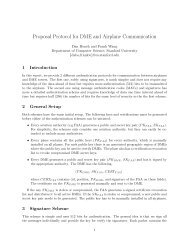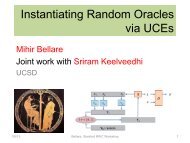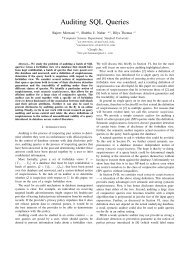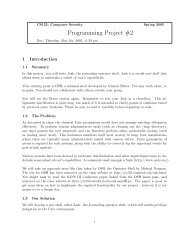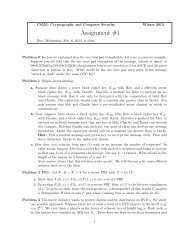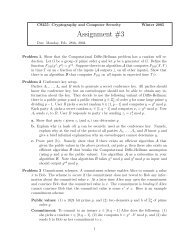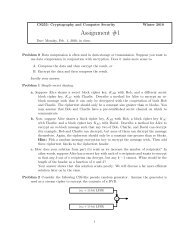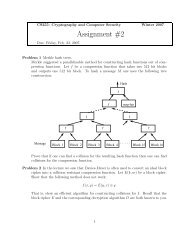Computing Arbitrary Functions of Encrypted Data - Stanford Crypto ...
Computing Arbitrary Functions of Encrypted Data - Stanford Crypto ...
Computing Arbitrary Functions of Encrypted Data - Stanford Crypto ...
You also want an ePaper? Increase the reach of your titles
YUMPU automatically turns print PDFs into web optimized ePapers that Google loves.
mial over x1, . . . , xt. These polynomials have degree at most<br />
t. Also, we know how to efficiently evaluate the elementary<br />
symmetric polynomials. They are simply coefficients <strong>of</strong> the<br />
polynomial p(z) = t (z−xi). An important point is that,<br />
i=1<br />
in our case, we only need to evaluate the polynomials up to<br />
degree α, since we know a priori that each <strong>of</strong> the Hamming<br />
weights is at most α. We saw in Section 3.3 that we can<br />
handle elementary symmetric polynomials in t variables <strong>of</strong><br />
degree up to about λ/ log t = Ω(λ/ log λ) for our suggested<br />
parameters. We can set α to be smaller than this.<br />
The final step <strong>of</strong> computing the sum <strong>of</strong> the bj’s does not<br />
require much computation, since there are only ℓ + 1 =<br />
O(log α) <strong>of</strong> them. We get that a ciphertext encrypting a<br />
bit <strong>of</strong> the overall sum has noise <strong>of</strong> at most N · α · g(log α)<br />
bits for some polynomial g <strong>of</strong> low degree. If the final sum<br />
modulo 2 is (b ′ 0, b ′ −1, . . .) in binary, then the rounding operation<br />
modulo 2 is simply b ′ 0 XOR b ′ −1. With the additional<br />
XOR operation in decryption, and possibly one more gate,<br />
the noise after evaluating the decryption function plus a gate<br />
has at most N · α · h(log α) bits for some polynomial h.<br />
The scheme E ∗ becomes bootstrappable when this noise<br />
has at most log(p/16) = P − 4 bits. For example, this works<br />
when α = λ/polylog(λ), N = λ, and P = λ 2 .<br />
5.4 Security <strong>of</strong> the Transformed Scheme<br />
The encryption key <strong>of</strong> E ∗ contains a hint about the secret<br />
p. But we can prove that E ∗ is semantically secure, unless<br />
either it is easy to break the semantic security <strong>of</strong> E (which<br />
implies that the approximate gcd problem is easy), or the<br />
following sparse (or low-weight) subset sum problem (SSSP)<br />
is easy: given a set <strong>of</strong> β numbers y and another number s,<br />
find the sparse (α-element) subset <strong>of</strong> y whose sum is s.<br />
The SSSP has been studied before in connection with<br />
server-aided cryptosystems. If α and β are set appropriately,<br />
the SSSP is a hard problem, as far as we know. In<br />
particular, if we set α to be about λ, it is hard to find the<br />
sparse subset by “brute force,” since there are β α<br />
≈ β pos-<br />
α<br />
sibilities. If the sparse subset sum is much closer to 1/p<br />
than any other subset sum, the problem yields to a lattice<br />
attack. But these attacks fail when we set β large enough<br />
(but still polynomial in λ) so that an exponential (in λ) number<br />
<strong>of</strong> subset sums are as close to 1/p as the sparse subset.<br />
Concretely, we can set β = λ 5 · polylog(λ).<br />
6. CONCLUSIONS<br />
We now know that FHE is possible. We already have the<br />
scheme presented here, the lattice-based scheme by Gentry<br />
[2, 3], and a recent scheme by Smart and Vercauteren [7].<br />
There is still work to be done toward making FHE truly<br />
practical. Currently, all known FHE schemes follow the<br />
blueprint above: construct a bootstrappable somewhat homomorphic<br />
encryption scheme E, and obtain FHE by running<br />
EvaluateE on E’s decryption function. But this approach<br />
is computationally expensive. Not only is the decryption<br />
function expressed (somewhat inefficiently) as a circuit,<br />
but then EvaluateE replaces each bit in this circuit with a<br />
large ciphertext that encrypts that bit. Perhaps someone<br />
will find a more efficient blueprint.<br />
The scheme presented here, while conceptually simpler,<br />
seems to be less efficient than the lattice-based scheme. To<br />
get 2 λ security against known attacks – e.g., on the the approximate<br />
gcd problem – ciphertexts are λ 5 ·polylog(λ) bits,<br />
which leads to λ 10 · polylog(λ) computation to evaluate the<br />
decryption function. The lattice-based scheme with comparable<br />
security has λ 6 · polylog(λ) computation. This is<br />
high, but not totally unreasonable. Consider: to make RSA<br />
2 λ -secure against known attacks – in particular, against the<br />
number field sieve factoring algorithm – you need to use<br />
an RSA modulus with approximately λ 3 bits. Then, RSA<br />
decryption involves exponentiation by a λ 3 -bit exponent –<br />
i.e., about λ 3 multiplications. Even if one uses fast Fourier<br />
multiplication, this exponentiation requires λ 6 · polylog(λ)<br />
computation. Also, unlike RSA, the decryption function<br />
in our scheme is highly parallelizable, which may make an<br />
enormous difference in some implementations.<br />
7. EPILOGUE<br />
The morning after her dream, Alice explains her glovebox<br />
solution to her workers. They are not happy, but they wish<br />
to remain employed. As the day progresses, it becomes clear<br />
that the gloveboxes are slowing down the pace <strong>of</strong> jewelry<br />
construction considerably. The main problem seems to be<br />
the thick gloves, which multiply the time needed for each<br />
assembly step. After a few days <strong>of</strong> low output, Alice curtails<br />
her use <strong>of</strong> the gloveboxes to pieces that contain the most<br />
valuable diamonds.<br />
Alice loses her suit against Acme Glovebox Company, because,<br />
as far as anyone knows in Alice’s parallel world, gloves<br />
in gloveboxes are always very stiff and stiffen completely after<br />
moderate use. The old judge explains this to her in a<br />
patronizing tone.<br />
But Alice refuses to give up. She hires a handsome young<br />
glovebox researcher, and tasks him with developing a glove<br />
flexible enough to permit the nimble assembly <strong>of</strong> jewels and<br />
unlocking <strong>of</strong> boxes, but sturdy enough to prevent the boxes<br />
from being easily compromised. The researcher, amazed at<br />
his good fortune, plunges into the problem.<br />
8. REFERENCES<br />
[1] D. Boneh and R. J. Lipton. Algorithms for black-box<br />
fields and their application to cryptography (extended<br />
abstract). In CRYPTO, pages 283–297, 1996.<br />
[2] C. Gentry. A fully homomorphic encryption scheme.<br />
PhD thesis, <strong>Stanford</strong> University, 2009.<br />
crypto.stanford.edu/craig.<br />
[3] C. Gentry. Fully homomorphic encryption using ideal<br />
lattices. In M. Mitzenmacher, editor, STOC, pages<br />
169–178. ACM, 2009.<br />
[4] S. Goldwasser and S. Micali. Probabilistic encryption.<br />
J. Comput. Syst. Sci., 28(2):270–299, 1984.<br />
[5] R. L. Rivest, L. M. Adleman, and M. L. Dertouzos. On<br />
data banks and privacy homomorphisms. In<br />
Foundations <strong>of</strong> Sec. Comp., pages 169–180, 1978.<br />
[6] R. L. Rivest, A. Shamir, and L. M. Adleman. A<br />
method for obtaining digital signatures and public-key<br />
cryptosystems. Commun. ACM, 21(2):120–126, 1978.<br />
[7] N. P. Smart and F. Vercauteren. Fully homomorphic<br />
encryption with relatively small key and ciphertext<br />
sizes, 2009. http://eprint.iacr.org/2009/571.<br />
[8] W. van Dam, S. Hallgren, and L. Ip. Quantum<br />
algorithms for some hidden shift problems. SIAM J.<br />
Comput., 36(3):763–778, 2006.<br />
[9] M. van Dijk, C. Gentry, S. Halevi, and<br />
V. Vaikuntanathan. Fully homomorphic encryption over<br />
the integers, 2009. http://eprint.iacr.org/2009/616.



